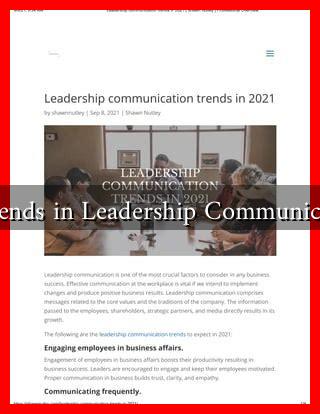-
Table of Contents
What Are the Trends in Leadership Communication Right Now
In today’s fast-paced and ever-evolving business landscape, effective leadership communication is more crucial than ever. As organizations adapt to new technologies, diverse workforces, and shifting market dynamics, leaders must refine their communication strategies to foster engagement, collaboration, and innovation. This article explores the current trends in leadership communication, highlighting key practices that are shaping the way leaders connect with their teams and stakeholders.
The Rise of Authenticity
One of the most significant trends in leadership communication is the emphasis on authenticity. Leaders are increasingly expected to be genuine and transparent in their interactions. This shift is driven by a growing demand for trust and accountability in organizations.
- Vulnerability: Leaders who share their challenges and failures create a culture of openness, encouraging team members to do the same.
- Storytelling: Authentic leaders often use storytelling to convey their vision and values, making their messages more relatable and impactful.
- Feedback Loops: Encouraging two-way communication fosters a sense of belonging and empowers employees to voice their opinions.
For example, Satya Nadella, CEO of Microsoft, has been praised for his authentic leadership style. By sharing personal stories and emphasizing empathy, he has transformed Microsoft’s culture and improved employee engagement.
Embracing Digital Communication Tools
The digital transformation has revolutionized how leaders communicate. With remote work becoming the norm, leaders are leveraging various digital tools to maintain connections with their teams.
- Video Conferencing: Platforms like Zoom and Microsoft Teams have become essential for virtual meetings, allowing leaders to engage face-to-face, even from a distance.
- Collaboration Tools: Tools such as Slack and Trello facilitate real-time communication and project management, enhancing team collaboration.
- Social Media: Leaders are using platforms like LinkedIn and Twitter to share insights, engage with followers, and build their personal brands.
A study by McKinsey found that organizations that effectively use digital communication tools can improve productivity by up to 25%. This statistic underscores the importance of embracing technology in leadership communication.
Focus on Emotional Intelligence
Emotional intelligence (EI) is becoming a critical component of effective leadership communication. Leaders with high EI can better understand and manage their emotions and those of their team members, leading to more effective interactions.
- Empathy: Leaders who demonstrate empathy can build stronger relationships and foster a supportive work environment.
- Conflict Resolution: High EI enables leaders to navigate conflicts more effectively, promoting a culture of collaboration.
- Motivation: Emotionally intelligent leaders can inspire and motivate their teams, driving higher levels of engagement and performance.
For instance, a study published in the Harvard Business Review found that leaders with high emotional intelligence are more likely to be perceived as effective by their teams, leading to improved organizational outcomes.
Prioritizing Inclusivity and Diversity
As organizations become more diverse, leaders must communicate in ways that are inclusive and respectful of different perspectives. This trend is not just about representation; it’s about creating an environment where everyone feels valued and heard.
- Inclusive Language: Leaders are adopting language that reflects diversity and avoids biases, ensuring that all team members feel included.
- Active Listening: Encouraging diverse voices in discussions fosters innovation and creativity.
- Training and Development: Providing training on cultural competence helps leaders communicate effectively across diverse teams.
Companies like Google have implemented initiatives to promote inclusivity in their leadership communication, resulting in a more engaged and innovative workforce.
Conclusion
In conclusion, the trends in leadership communication are evolving rapidly, driven by the need for authenticity, the rise of digital tools, the importance of emotional intelligence, and the focus on inclusivity. Leaders who adapt to these trends will not only enhance their communication effectiveness but also foster a more engaged and productive workforce. As organizations continue to navigate the complexities of the modern business environment, embracing these trends will be essential for successful leadership.
For further insights on leadership communication, consider exploring resources from the Harvard Business Review or McKinsey & Company.

